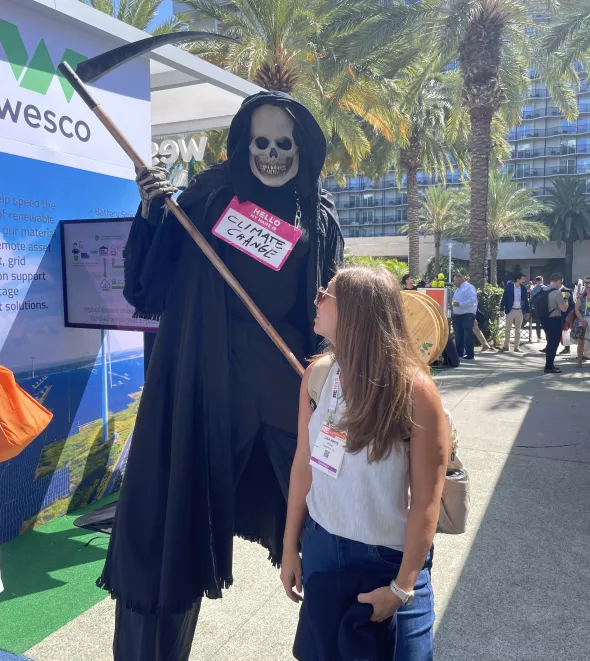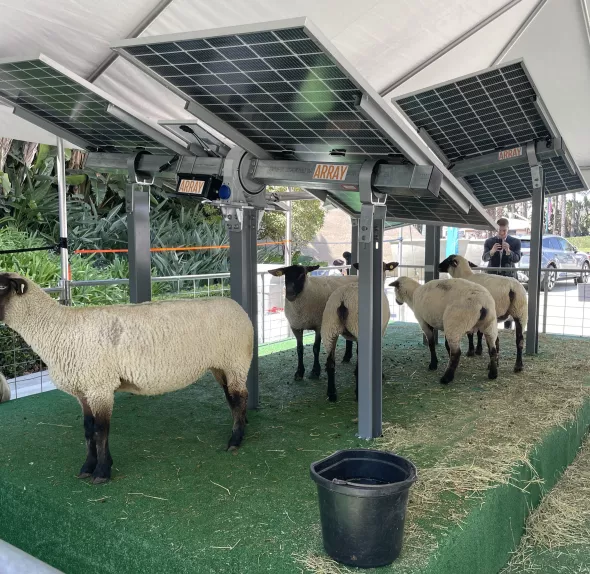Report from North America's Largest Clean Energy Event
Phius Co-Executive Director Lisa White recounts her experience speaking at and attending RE+.
Phius Co-Executive Director Lisa White recounts her experience speaking at and attending RE+.
A few weeks ago, I had the pleasure of attending North America’s largest clean energy event, RE+, co-hosted by the Solar Energy Industries Association (SEIA) and Smart Electric Power Alliance (SEPA).
I was invited to speak at the “Grid-Edge Theater” on the show floor. The theater space was programmed and hosted by the EMerge Alliance, a non-profit organization focused on creating and promoting standards for direct current (DC) and hybrid AC/DC power infrastructure in buildings, neighborhoods, and communities in order to provide a more resilient and secure energy future.

The “grid edge” is a term that’s become more commonly used to describe the distributed energy resources (equipment, software, and controls) that exist on the customer end of the grid. The name refers to the proximity of these resources to the end-user relative to the more commonly thought-of centralized grid network. The grid edge includes building-mounted energy storage systems, renewable energy systems, building energy management systems, microgrids, etc. There is a lot of focus on solutions at the grid edge, as this is what can facilitate flexible loads in buildings, manage EV charging, increase self utilization of on-site PV, and avoid significant upgrades in the larger electricity transmission and distribution networks as we accelerate growth in renewable energy.
My talk was focused on the critical role of passive buildings in the energy transition. I’ve talked about this before, but it’s important to remember that the grid was built to power buildings. We’re changing how and when buildings use electricity by electrifying heating and hot water loads. And let’s not forget that the grid must also support the growing demand for charging electric vehicles. And then there’s artificial intelligence (AI), which can play a huge role in planning for meeting the electricity demand while also adding a monstrous load itself. All of this change is happening alongside significant goals of retiring dispatchable fossil-fueled power plants that can ramp up and down to keep up with demand, and replacing that power supply with variable renewable resources.
There’s a lot of moving pieces. But no matter how you slice it, if we build passive buildings, we can reduce the electricity demand needed for buildings, avoid the “spikey” loads that electrifying heating creates in many buildings, align more renewable supply with building demand, and accelerate the growth of new renewable energy deployment.

The RE+ opening keynote was delivered by Padma Lakshmi, who I was excited to see, as a fan of Top Chef. I was intrigued, wondering what Padma could say to an audience of clean energy professionals. But she was able to make the connection; she talked about how she made Top Chef successful by understanding the perspective of each competitor in the show, listening to their stories, and then making those stories heard so viewers wanted them to succeed. This is what we need to do with the clean energy transition – bring it close to home and give it purpose. She said something else that resonated with me – that each chef had a unique perspective on each challenge, yet all of them shared a common goal. This is how the clean energy industry is operating today: toward a common goal. All the unique perspectives are spurring innovation and growth at a rate unparalleled in the past.
The conference itself was enormous. I knew it was big, but I didn’t know how big. There were more than 40,000 attendees and 13,000 exhibitors. With a conference of this size, my gut reaction was kind of “gah, more gimmicks.” Walking around the massive exhibit floor, you saw exhibits bigger than my home stacked with games, giveaways, fancy seating, and even a mechanical bull. These vendors were really committed to promoting their product. At first, it felt off-putting. But then that’s when it clicked with me – that this had reached the mainstream. And I became overwhelmingly optimistic about our clean energy future. At Phius, we’re just beginning to break the barrier into a more “mainstream” crowd, but at RE+, they were there.
The amount of intelligent minds (and deep pockets) devoted to the clean energy transition was truly inspiring and solidified for me that the momentum behind the transition would take a gargantuan force to be stopped.